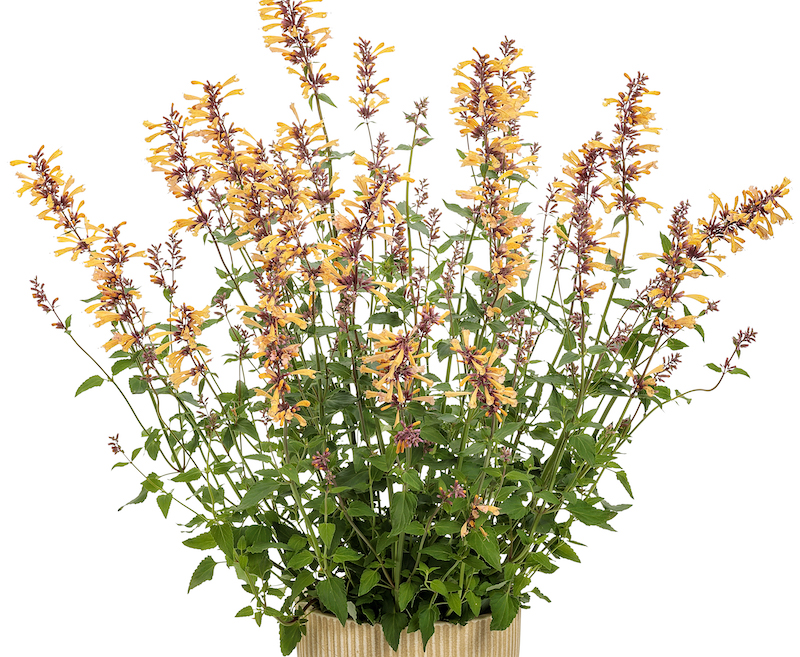Agastache can be grown very easily in a wide variety of planters or pots. This plant is the perfect attractor of pollinators to your garden and can be used in even the smallest of patios or balconies. Most varieties of Agastache stay under 3 feet tall and wide and work as the thriller or filler element in a mixed planting for seasonal color. When grown in containers, Agastache may be treated as an annual, allowing the gardener to change color or planting schemes the following season.

Planting Agastache in Pots
Planting your containers as early in the spring as possible allows the plants to establish a stable root system before the heat of summer kicks in. Agastache is a hardy perennial and can be planted as soon as the soil warms in the spring. A late frost or two after planting will not hurt Agastache. If many nights of unusual frost are predicted, cover your pots with horticultural fabric or an old sheet until the weather warms. If the containers are small enough, move them to a more protected location near the house or inside an unheated garage.
Place your containers in a sunny position with at least 6 hours of full sun to maximize blooming and reduce the chances of fungal diseases on the foliage. Plant Agastache either alone or in containers with other water-wise plants that prefer full sun. Some great companions are lavender, rosemary, coneflowers, and ornamental grasses. Any container can be used as long as it has drainage holes in the bottom. Place the pot on bricks or pot feet to create space for excess water to drain off.
Best Soil For Agastache in Pots
Although Agastache prefers soil with a slightly acidic pH, an all-purpose potting mix works well and is easy to use for a wide variety of plants. Look for a mix containing plenty of perlite for good drainage. Soils that have added fertilizers in them may be too rich for Agastache, although regular watering will leach the nutrients from the soil over time. Organic compost can be added as a top-dressing for the soil. It will shade the roots, helping to keep the plants cooler while also allowing the soil to retain moisture longer after watering.
Caring For Agastache in Planters
Growing Agastache in containers is a great way to attract native pollinators to a small container garden, deck, or balcony. There is a wide variety of cultivars to choose from to get just the right look and size for your space. Perennials growing in pots require slightly different watering and fertilizing schedules from garden-grown plants, although Agastaches are still some of the easiest plants to grow for either new or experienced gardeners.
Watering Agastache in Pots
Agastache plants develop drought tolerance over time, whether grown in the garden or in a container; however potted plants will require supplemental watering on a more regular basis. Do not allow more than the top 3 inches of potting soil to dry between waterings. If the soil is so dry that it is pulling away from the sides of the pot, immediate action will be needed to rehydrate both the soil and the plant. Water until liquid drains from the drainage holes. This ensures that all of the potting mix is saturated.
When watering, focus on wetting the soil and keeping the foliage as dry as possible. Wet foliage makes it easy for diseases and pests to attack plants. During hot periods, watering may be needed daily. During periods of overcast, cool weather (early spring or fall), restrict supplemental watering. Moisture evaporates more slowly from cool soil, and plants going into dormancy require less water to support dying top growth.
Fertilizing Agastache in Pots
Potted Agastache requires a little extra fertilizing to replenish the nutrients that are leached out by regular watering. Supplement one watering a month with a diluted liquid fertilizer. Liquid seaweed, fish emulsion, or compost tea are all good choices to support healthy growth and bright-colored flowers. Look for a brand that displays the OMRI stamp of approval on the label. This ensures that the formulation adheres to organic growing standards. Do not fertilize past the end of August, so that the Agastache and any other perennials in the container can begin preparing for winter dormancy.
Winter Care For Agastache in Pots
If possible, move containers to a protected location near the house or out of the path of prevailing winter winds. Containers may need extra insulation if you are gardening in zones 4-6 and have periods of temperatures below 0 degrees Fahrenheit regularly. Wrapping the pot in layers of burlap or horticultural fabric will trap air for extra warmth of the root system.
Growing Agastache Indoors
Agastache is not a good candidate for growing as a houseplant in the winter. Like other herbaceous perennials, all of the top growth dies back in cold weather to allow the root system a period of dormancy. This will happen even if you bring the plant inside. Agastache prefers a period of vernalization (cool temperatures) during dormancy and may not grow well without it. The seeds also require cold treatment to germinate successfully. Planting the seeds in trays and growing them in an unheated greenhouse or cold frame will provide you with seedlings once the weather warms in the spring.
 |
Author Robbin Small - Published 7-16-2023 |
